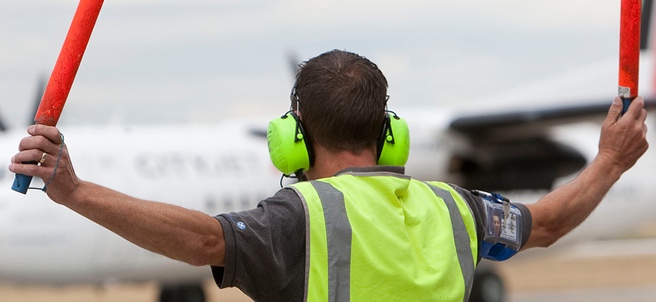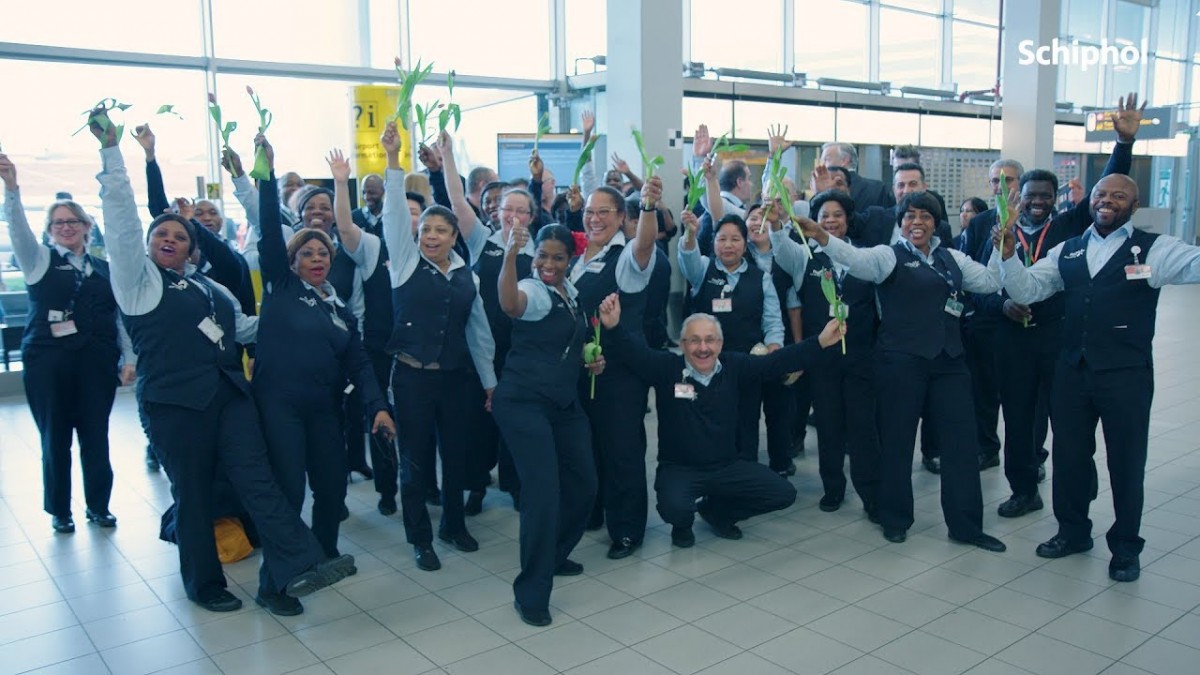by Max Hirsh and Moe Kamleh
This is the second article in a series about what makes an airport resilient, and why resilience matters for the aviation industry. Today, we focus on two key aspects: workforce resilience and network resilience.
by Max Hirsh and Moe Kamleh
This is the second article in a series about what makes an airport resilient, and why resilience matters for the aviation industry. Today, we focus on two key aspects: workforce resilience and network resilience.

Last time, we investigated two of the four key pillars of a resilient airport: operational resilience—that is, an airport’s ability to maintain operations in the wake of unforeseen events—and financial resilience, i.e. an airport’s ability to weather economic crises by diversifying its revenue sources.
Airports depend on operational and financial resilience in order to mitigate the impact of external shocks—terror attacks, economic recessions, natural disasters, public health emergencies—that wreak havoc on aviation on a regular basis. But in order to withstand such stressful periods, airports also depend on the resilience of the millions of women and men who work in our industry. Like any complex system, airports cannot operate without a resilient workforce. Their success also depends on maintaining resilient relationships with key partners across the industry.
That crucial human factor is the topic of today’s article. It’s also the driving force behind the third and fourth pillars of a resilient airport: workforce resilience and network resilience.

The basic building block of any organization is its workforce. To achieve operational resilience, smart airports equip their staff with the know-how needed to succeed across the airport’s very different operational environments. As airports plan for life after COVID, how can they build agile teams and prepare their staff for the challenges that lie ahead?
One option is to remove the human factor altogether through automation. In recent years, many airports have tried to eliminate the costs and complexities involved in managing large numbers of people by prioritizing digitalization. The basic argument is that the high upfront capex required to automate operational processes is justified by the long-term reduction in labor costs. This makes sense for airports in places with high wages and high levels of technical literacy (the argument is much weaker elsewhere). And it makes a lot of sense when it comes to building new terminals: a complex task that can be greatly simplified through innovative construction technologies. But as we have discussed elsewhere, automation isn’t a magic potion to cut costs and raise efficiency.
Automated procedures are designed by engineers, supervised by airport staff, and utilized by passengers. There are many good examples of user-friendly technologies that are a win-win for both airports and their customers: allowing travelers to save time and airports to save money. But there are also plenty of buggy apps, dysfunctional e-gates, and software that randomly crashes at the worst possible moment, leaving staff scrambling to create contingency plans on the fly. Moreover, while automation enables airports to reduce their front-line staffing needs, it creates a new dependency on a different (and much more expensive) workforce of programmers and IT specialists. Whether they like it or not, airports will always need a workforce. But they can’t afford to ignore the innovative potential of automation. Rather than prioritizing technology over people, successful airports aim to achieve an optimum balance between the two.
Maintaining a flexible workforce that can react quickly to any situation is an essential precondition of airport resilience. Staff need to be equipped not only with detailed technical and operational knowledge, but also with a set of professional skills—such as critical thinking, multi-tasking, and improvisation—that can be applied across a wide range of airport functions. Doing so will empower our workforce to engage with rapid changes in technology and regulations, and to respond effectively to unforeseen events.
How can airports build and maintain a resilient workforce? We propose three strategies.
First, successful airports rely on cross-training: rotating staff between different tasks—and familiarizing them with the airport’s different working environments—so that employees can be flexibly deployed whenever staffing needs grow (or shrink) in specific operational areas. The results have been evident during the current crisis. Airports that cross-train their staff encountered significantly fewer challenges when it came time to redeploy employees in response to the very different operational requirements ushered in by the pandemic.
The second success strategy for building a resilient workforce is to hire for the future, not for today. Airport hiring practices are often reactive in nature: that is, the search for talent begins when an urgent need arises, or when a talented coworker departs. At that point, however, it’s usually too late: the lead time required to identify, interview, and onboard new staff can last anywhere between six and 12 months, leading to significant gaps in capability in the meantime.
That said, it can be difficult to predict future staffing needs in an industry as dynamic as aviation. Successful airports engage with that conundrum in several ways. They begin by studying average turnover rates. How long do different types of employees typically remain with the organization, and how often do they get poached by rivals? Next, they assess the relative dynamism of their institutional culture. Is the airport run by a healthy mix of seasoned veterans and industry newcomers, allowing for a productive dialogue between experienced know-how and fresh ideas? Or is the airport staffed entirely by ‘lifers’ who lack a big-picture perspective and are resistant to change?
Drawing on those data points, successful airports design an onboarding cycle that anticipates future turnover and ensures regular infusions of new insights and perspectives. For example, an airport might aim to recruit a multidisciplinary pool of junior staff every three to five years, and cross-train them in various departments to prepare them to become future leaders.

That leads us to the third and final strategy for maintaining a resilient workforce: investing in education. Few institutions of higher learning offer a diversified aviation program that is aligned with the industry’s current needs. As a result, airports commonly train new staff themselves: initiating them into the procedural standards and weird cult of acronyms that pervades the world of aviation (BHS, MCT, IROPS, anyone?). At the same time, successful airports encourage veteran employees to embrace the rapidly changing demands of our industry by providing ample opportunities for continuing education.
In-house training provides senior colleagues an opportunity to mentor junior staff, and to brush up on the latest industry trends. It also increases staff retention by instilling a sense of purpose and loyalty to the organization. In recent years, bespoke training academies—tailored to the unique operational needs of a specific airport—have become more common: Hong Kong, Munich, and Singapore are all good examples.
But while establishing an in-house training program makes sense at a large hub with thousands of employees, it can be difficult for small and medium-sized airports to justify the expense. Successful ones rise to the challenge by pooling limited resources with their peers. For example, a national aviation authority, or a private concessionaire, can create a centralized training program at its head office to serve an entire network of airports—both large and small. Moreover, these shared training programs create opportunities for staff to circulate between different airports within the network, exposing them to different operational environments and new ways of thinking.
At a time when the entire aviation industry is in crisis, the idea of investing in education can be a tough sell. Most airports are struggling to keep the lights on; understandably, many don’t view staff training as a priority. By contrast, successful airports are doubling down on their commitment to continuing education. They understand that retraining is essential to equip their staff with the new skills and new knowledge that they will need to tackle the challenges ahead, and to finding new opportunities for growth.

Network resilience extends the principles of workforce resilience to the entire professional and institutional ecosystem in which the airport is embedded. Simply put, network resilience can be measured by the strength of the ties that bind an airport to its key partners in the public and private sectors. Apart from airlines and regulators, those partners typically include concessions operators and tenants, ground handlers, subcontractors, health, customs, and immigration authorities, as well as members of the local community.
Airports and airlines depend on each other for their mutual success. Global hubs like Amsterdam and Singapore owe their success to their home carriers, just as airlines like KLM and Singapore Airlines rely on the excellent infrastructure provided by their hubs in order to maintain both their reputation and profitability. At the same time, successful airports nurture positive ties with government authorities at the local, regional, and national level. Those relationships touch on nearly every issue an airport deals with: ranging from nuts-and-bolts permitting and zoning issues with the local municipality to long-term strategic goals that depend on policy support and regulatory approval at the national level.
Moments of crisis, such as COVID-19, put those relationships to the test. In less successful cities, dysfunctional ties between the airport, airlines, local communities, and regional and national governments have long been a barrier to success. Corona has exacerbated those long-standing feuds, leading to ugly squabbles about overdue payments, job cuts, and how best to contain the virus’s spread among air travelers. By contrast, successful airports have capitalized on the resilience of their network, liaising quickly with immigration and public health agencies to roll out testing and contact tracing procedures, and developing a coordinated response to this year’s bewildering sequence of events (more on that here). Moreover, successful airports leveraged network resilience to mitigate COVID-19’s economic impact, coordinating with airlines, vendors, and local municipalities to develop repayment plans and job retention schemes.
Airports are complex, demanding beasts that require round-the-clock attention. Many managers and decision makers struggle to find the time and energy needed to maintain good relations with the airport’s key partners, such as airlines and regulators. The result is that connections beyond the airport authority’s own walls can be weak, even downright hostile. In such cases, COVID-19 may end up being a boon for airports where network resilience is poor. As airports, airlines, and governments grapple with diminished budgets for years to come, it’s essential for all of the airport’s partners to find opportunities to pool financial resources and know-how, align their recovery plans, and grow together for mutual benefit. In the long term, strengthening airports’ network resilience will place them in a better position the next time a major crisis strikes.

We have identified four key pillars of resilience—operational, financial, workforce, and network—that empower airports to survive, and even thrive, during prolonged periods of stress. Successful airports that focus on these four pillars encounter fewer challenges when unforeseen events occur, and they tend to bounce back from them more quickly. Moreover, airports that invest in resilience are more adept at finding new opportunities for growth when existing ones disappear.
The pandemic exposed a range of structural weaknesses in the aviation industry: notably, an overreliance on too few sources of revenue, as well as lack of coordination among key industry players. Perhaps most upsettingly, the current crisis revealed an inability to enforce universal health and safety standards—such as requiring all staff and all pax to wear a mask, with no excuses or exceptions. That’s shaken our customers’ confidence, prompting many to question whether it’s safe to fly.
Moving forward, we need to learn from these missteps—and strengthening our resilience is the key.
Special thanks to Ginger Evans.